
19 Best Email Deliverability Tools for 2026
Email deliverability is one of the most important factors in email marketing success. If your emails aren’t landing in the inbox, your email marketing isn’t working. And with stricter spam filters, evolving ISP rules, and tighter sender reputation thresholds, you need the right infrastructure and the right tools.
Email deliverability depends on multiple factors: domain authentication (SPF, DKIM, DMARC), IP reputation, bounce rates, engagement metrics, and spam scores. If any part of this system fails, your message gets filtered or blocked entirely.
This guide breaks down the best email deliverability tools, including both:
- Full-service email platforms with built-in deliverability safeguards.
- Standalone tools for testing, monitoring, warming up, and improving inbox placement.
If your campaigns are underperforming and you suspect deliverability is the issue, this is where to start.
Top Email Deliverability Tools
Below, you’ll find our curated list of tools. The list includes pricing and deliverability data from trusted third-party tests, where available.
Note: Deliverability scores in this guide come from third-party testing tools like EmailToolTester and user benchmarks, which simulate inbox placement through seed testing. While these provide valuable insights, actual results may vary depending on your audience, content, and sending practices. For best results, pair these tools with your own inbox monitoring and ongoing list management.
All-in-one email marketing platforms
Here are some of the best email solutions with high deliverability scores.
| Key Features | Deliverability Score | Pricing | |
| Moosend | Strong sender reputation controls, advanced segmentation, and built-in spam testing | 90.1% | $9/month, 30-day free trial |
| Constant Contact | Dedicated IP address for full control over sender reputation | 91.7% | $12/month, 30-day free trial |
| Mailchimp | DKIM and SPF setup assistance, engagement-based list targeting | 89.5% | $13/month, free plan for 500 contacts |
| Brevo | Basic deliverability dashboard, supports SPF, DKIM, and DMARC | 88.3% | $9/month, free plan for 300 emails/day |
| MailerLite | Built-in tool for scrubbing inactive subscribers, SPF, DKIM, and DMARC record setup | 89.8% | $10/month, free plan for 1,000 subscribers |
| ActiveCampaign | Domain verification and campaign preview | 94.2% | $15/month, 14-day free trial |
| Omnisend | Bounce management and spam complaint tracking, SPF, DKIM, and DMARC setup | 75.1% | $16/month; free plan of 250 contacts and 500 email sends/month |
| Kit (formerly ConvertKit) | Deliverability reports, sending domains verification | 91.3% (as of January 2023) | $29/month; free plan for 1,000 subscribers |
| GetResponse | Strict anti-spam policies, auto-removes inactive email addresses | 90.9% | $16/month, free 30-day trial |
| MailJet | Sending domain authentication, supports SPF, DKIM & DMARC | 88.0% | $17/month, free plan for 6,000 emails/month |
Dedicated deliverability, testing & monitoring tools
Here, you can find some dedicated options for more thorough testing and monitoring.
| Key Features | Best For | Pricing | |
| Moosend DMARC Checker | DMARC record validation, domain authentication set up | Protecting sender reputation and passing ISP filters | Free tool |
| GlockApps | Inbox placement testing, blacklist monitoring, and spam filter diagnostics | Domain and IP reputation monitoring | $59/month, free plan (with limitations) |
| Mailreach | Email warm-up service that mimics real engagement to build sender reputation | Inbox placement monitoring and domain scoring | $25/month/inbox |
| InboxAlly | Email warmup service | Behavioral signals that train inbox providers like opens, replies, and bookmarks | $149/month |
| MailGenius | Holistic spam score with detailed reports that feature actionable breakdowns | Quick deliverability audits | $10/month, free plan for 1,000 subscribers |
| Mailtrap | Checks headers, spam triggers, and authentication setup | Simulating email sending for testing without hitting real inboxes | $15/month for the email sending plan, free plan |
| Postmark | Transactional email API with industry-leading deliverability | Separate sending infrastructure from marketing emails | Transactional email API with industry-leading deliverability |
| MXToolbox | Full suite for DNS, SMTP diagnostics, blacklist monitoring, SPF/DKIM/DMARC validation | Powerful diagnostic lookups | $129/month, free tools |
| ZeroBounce | Email list validation, email server testing, inbox placement testing, DMARC monitoring | Maintaining a clean email list and protecting sender’s reputation | $18/month, free deliverability toolkit |
How We Chose These Tools
For this list, we focused on platforms and tools that actively help marketers reach the inbox. Here’s the criteria we used to evaluate the best email deliverability tools.
Infrastructure and reputation
We prioritized tools with consistently high inbox placement across major providers like Gmail, Outlook, and Yahoo, as well as dedicated IP options, authenticated sending domains (SPF, DKIM, DMARC), and proactive reputation management.
Real-time monitoring and alerts
Since email deliverability isn’t static, we looked for tools that offer real-time monitoring, blacklist notifications, and inbox placement alerts. These features are especially valuable for senders running cold email or high-volume campaigns where sudden drops can severely impact performance.
Email testing features
Platforms that provide comprehensive email testing tools, including spam score analysis, authentication checks, and preview rendering, are a core part of the list. These functions help identify issues before hitting “send,” reducing the risk of poor delivery.
Integrations and automation
Platforms that integrate with CRMs, eCommerce systems, and analytics tools help streamline campaign workflows and maintain list quality. We also valued automation features that support warm-up sequences, engagement filtering, and list hygiene.
Ease of use and pricing transparency
Deliverability tools don’t need to be overly complex. We favored platforms with clear documentation and transparent pricing models. The tools featured in this article are well-known for their ease of setup and user-friendly dashboards. Finally, the transparent pricing models can help users pick the right plan.
Email Marketing Platforms with Great Deliverability Scores
When you’re running newsletters, eCommerce campaigns, or cold email campaigns, hitting the inbox is everything. The tools below were handpicked for their ability to support reliable sending, flag potential issues early, and improve overall deliverability. Whether you’re looking for a full-service platform or a specialized testing tool, these options are built to help your emails reach their destination.
The following tools stand out not just for their marketing features, but for their consistent deliverability performance, warm-up protocols, and sender reputation safeguards. Each one balances usability, scalability, and reliability with measurable email success.
1. Moosend
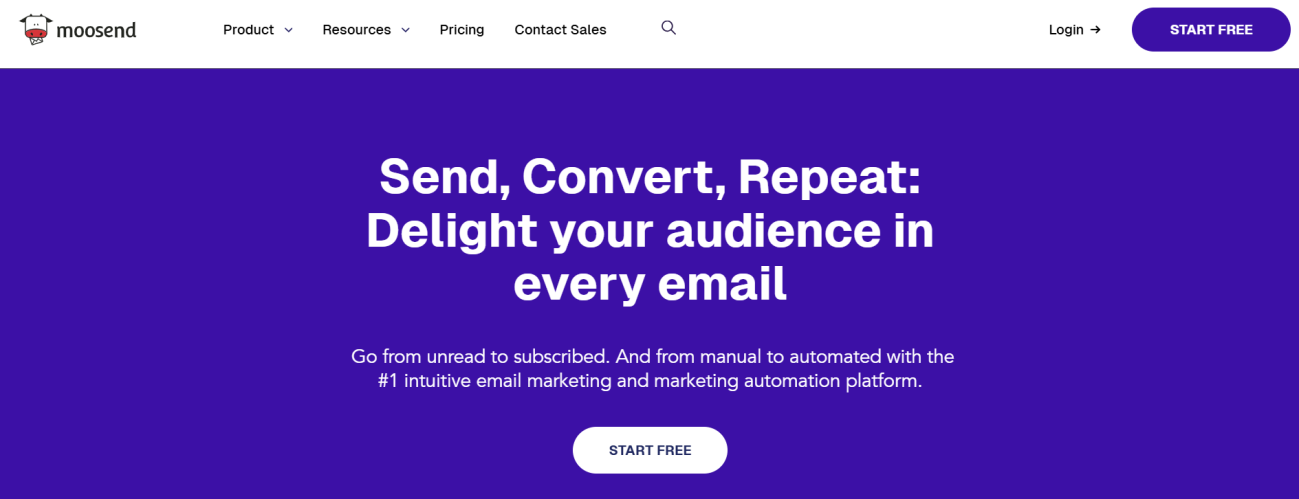
Pricing: Starts at $9/month, offers a free 30-day trial (Sign up here)
Moosend is one of the most reliable platforms when it comes to deliverability in email marketing. With a consistent 90.1% inbox placement rate, it offers advanced sender reputation tools at a fraction of the price of its competitors.
Moosend provides native support for DMARC, SPF, and DKIM, and includes a free DMARC checker to help users verify domain authentication before they even hit send. It also supports list cleaning, spam testing, and bounce tracking, helping marketers maintain healthy sender scores.
Moosend also offers bot prevention by filtering out automated actions with 98% accuracy, making it a high-performing email deliverability tool that supports clean, trustworthy engagement data. The platform is also certified by the Certified Senders Alliance (CSA) and is a member of M3AAWG.
Apart from the deliverability features, Moosend comes with a flexible automation workflow builder, real-time analytics, a clean UI, and ready-made email templates geared toward fast campaign launches.
Moosend is ideal for businesses that need a powerful all-in-one solution that can help you craft campaigns and work your way out of the most common deliverability issues, such as ill-timed messages or non-custom domains.
Pros
- Enterprise-grade deliverability tools at a low price.
- Real-time automation triggers and performance reports.
- Spam scoring tools included.
Cons
- Native integrations are fewer than those of competitors.
- Doesn’t offer built-in list-cleaning tools.
2. Constant Contact

Pricing: Starts at $12/month, 30-day free trial is available
Constant Contact is an email marketing platform with consistently high deliverability rates. It averages 91.7% inbox placement, thanks to its dedicated IP options, feedback loop monitoring, and rigorous bounce management system.
Constant Contact is suitable for small to mid-sized businesses that want deliverability peace of mind without building from scratch. While it doesn’t give you deeply customizable DNS authentication tools, it provides guided domain verification and keeps your sender reputation clean with built-in spam complaint tracking.
Couple the above with its no-code email editor and reliable automation workflow engine, and you get a dependable choice for steady email performance. It’s a great choice for SMBs and event marketers that want built-in event management and deliverability options.
Pros:
- Delivers reliably to inboxes across major ISPs.
- Access to dedicated IPs for high-volume senders.
- Easy-to-use interface and template library.
Cons:
- Limited automation on lower-tier plans.
- Fewer advanced testing tools for email previews or spam scoring.
3. Mailchimp

Pricing: Paid plans start at $13/month, free for up to 500 contacts
Mailchimp offers basic deliverability protection, with a deliverability score of 89.5% and strong infrastructure backing from Intuit.
It guides users through SPF and DKIM setup, verifies custom sending domains, and automatically manages bounce handling to keep lists healthy.
Unlike some of its main competitors, Mailchimp lacks advanced spam testing and detailed reputation insights. Mailchimp users—especially those using shared IP—don’t get access to granular data about IP/domain reputation, blocklists, or detailed bounce reason codes, according to more technical senders.
However, the email platform makes up for these limitations with clean opt-in processes and powerful audience segmentation, which reduces engagement-based filtering. It’s ideal for startups, creators, or eCommerce stores that want reliable delivery and growth-focused automation tools in a single platform.
Pros:
- Guided domain authentication setup.
- Great for behavioral segmentation and testing.
- Reliable infrastructure and delivery at scale.
Cons:
- No native spam testing or inbox preview tools.
- Deliverability control is limited to standard authentication.
4. Brevo
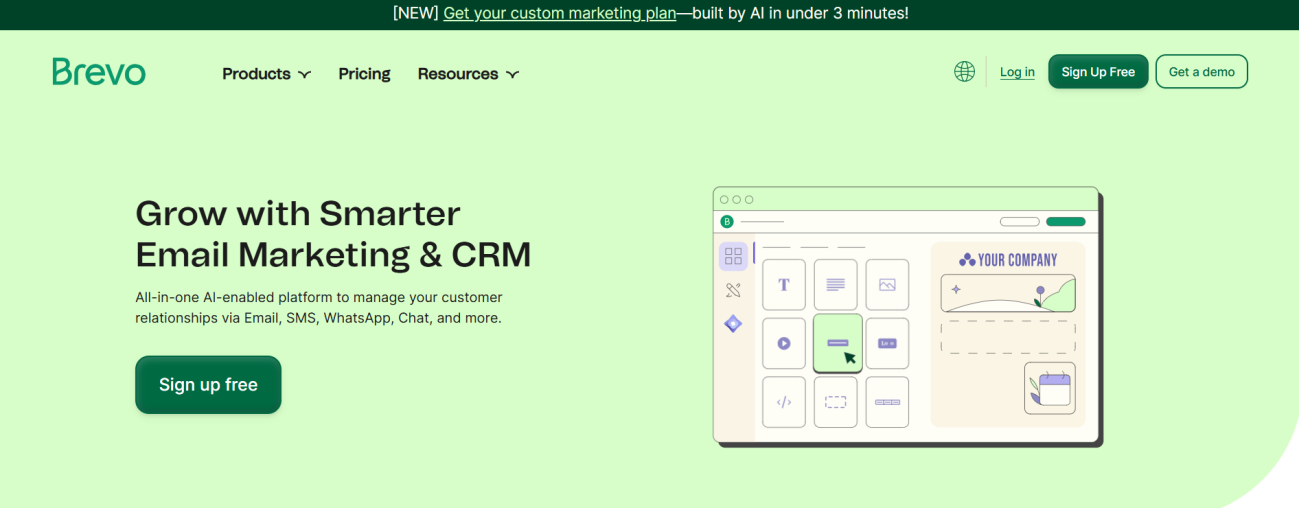
Pricing: Paid plans start at $9/month. Free plan for up to 300 emails/day.
Brevo offers a unified platform for marketing automation and transactional email, appealing to tech-savvy teams who want multichannel outreach through email, SMS, and WhatsApp from one dashboard. According to some users, its interface can feel clunky for complex workflows. However, Brevo makes up for it by providing strong value through integration, automation, and compliance.
With an 88.3% deliverability rate, Brevo supports dedicated IPs, manual DKIM setup, and full authentication (SPF, DKIM, DMARC), as well as message-level logs for transactional email. It also prioritizes GDPR compliance, making it ideal for privacy-focused or EU-based businesses.
Though lighter on analytics, Brevo balances functionality and control, especially for teams seeking efficiency without juggling multiple tools.
Pros:
- Great balance between transactional and marketing use.
- Strong infrastructure for high-volume or API-based email.
- Fully GDPR compliant with EU data centers.
Cons:
- Dated user interface compared to competitors.
- Support quality varies by pricing tier.
5. MailerLite

Pricing: Free for up to 1,000 subscribers. aid plans start at $10/month.
MailerLite is a favorite among content creators, coaches, and consultants. According to EmailToolTester’s January 2024 report, its 89.8% inbox placement rate shows the platform’s commitment to sender reputation and email hygiene.
Behind that performance is a clean infrastructure that enforces anti-spam policies and encourages best practices like domain authentication. MailerLite offers native tools to help users configure SPF and DKIM, and although DMARC setup is more manual, helpful guidance is available.
Keeping lists healthy is also baked into the platform. It features automatic bounce suppression, engagement-based segmentation, and workflows to help you identify and prune inactive subscribers. Paired with its intuitive interface and affordable pricing, MailerLite is an excellent choice for solo marketers who want their messages to land in the inbox without using complex tools.
Pros:
- Simple DNS authentication and list cleaning.
- Simple email builder and automation workflows on all plans.
Cons:
- Lacks advanced email preview features and built-in spam filter testing.
- Third-party integrations aren’t as extensive as other platforms.
6. ActiveCampaign
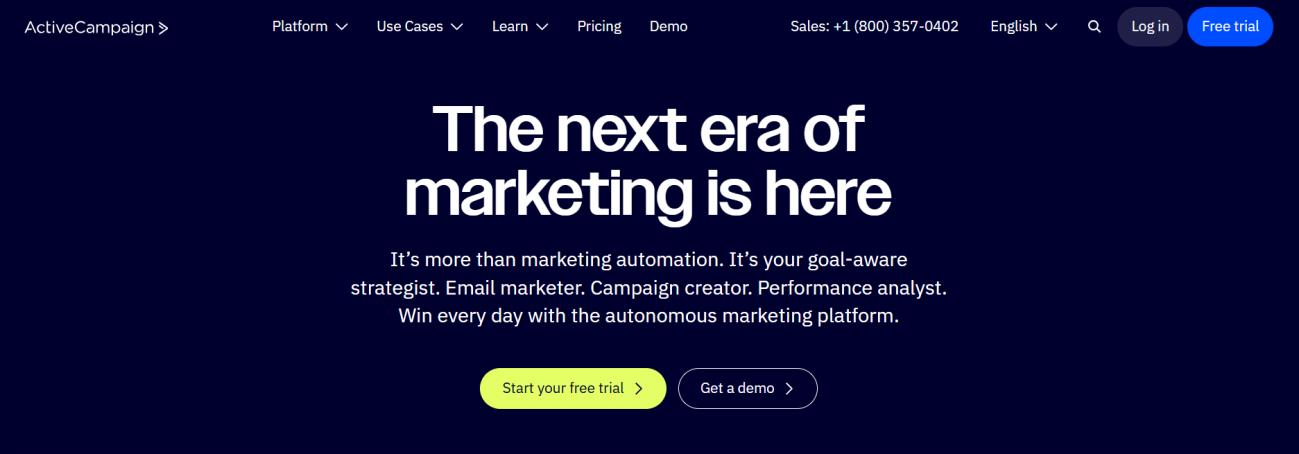
Pricing: Paid plans start at $15/month, includes a 14-day free trial.
ActiveCampaign stands out for its powerful automation capabilities. With a strong emphasis on sender reputation and deliverability, the email tool boasts a score of 94.2%.
The platform includes domain authentication (SPF, DKIM, DMARC), with clear setup instructions. It also uses verified domains to send emails and protect the sender’s reputation.
Its advanced contact engagement tracking (opens, clicks, site visits, email replies), and preview tools that come in the form of inbox previews and testing features for potential spam triggers help avoid common mistakes before sending, according to users.
Its combination of sophisticated automations, strong deliverability through dedicated IPs, and engagement segmentation makes it particularly strong for businesses that want to combine automation workflows with a serious approach to inbox placement.
Pros
- Deep engagement tracking that boosts deliverability.
- Reliable authentication tools and strict anti-spam policies.
Cons
- Steeper learning curve for beginners.
- No free plan.
7. Omnisend
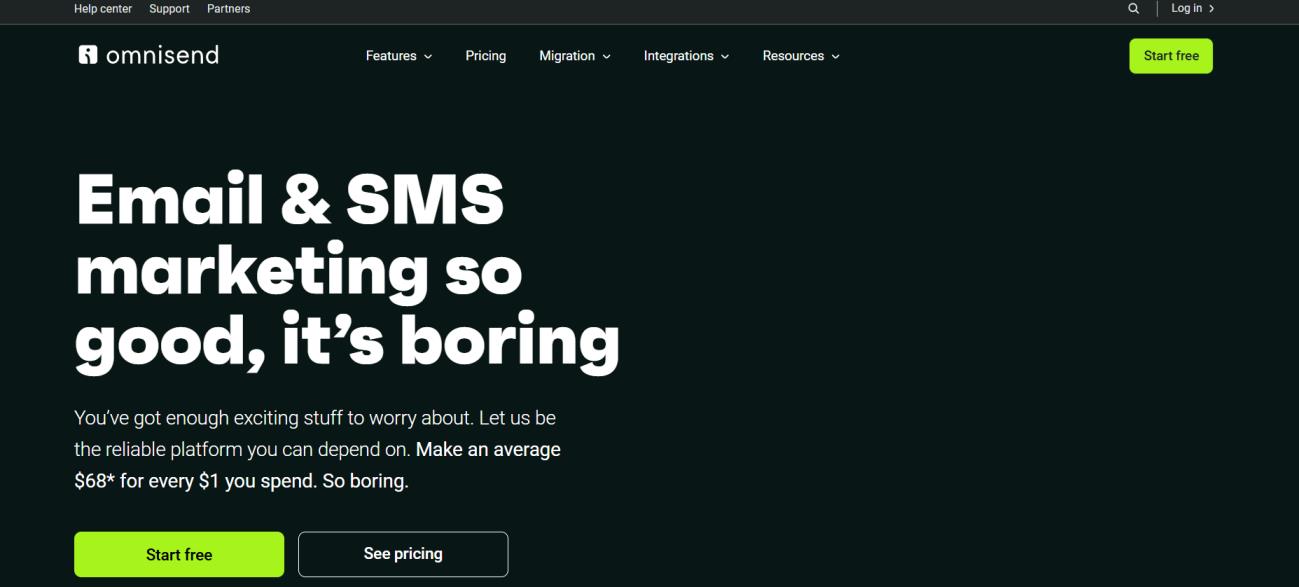
Pricing: Free for up to 250 contacts and 500 email sends/month. Paid plans start at $16/month.
Omnisend is a favorite among online stores for its dedicated eCommerce automation tools. However, its deliverability score of 75.1% shows room for improvement compared to its competitors.
That said, it includes several helpful tools such as bounce management and spam complaint tracking. Users can set up SPF/DKIM/DMARC to authenticate their domain, which gives them control over their sender reputation. The setup is manually done and not guided by a built-in wizard.
While these features offer basic reputation controls, user forums report that it doesn’t offer in-depth reputation analytics or advanced deliverability diagnostics compared to other platforms.
It’s a useful tool for eCommerce-focused teams that want targeted campaigns with some deliverability support, although high-volume senders may need to monitor performance closely.
Pros
- Strong eCommerce automation features.
- Helps manage bounce rates and complaint feedback on a basic level.
Cons
- Lower deliverability rates than most.
- Requires more manual monitoring to optimize inbox placement.
8. Kit (formerly ConvertKit)
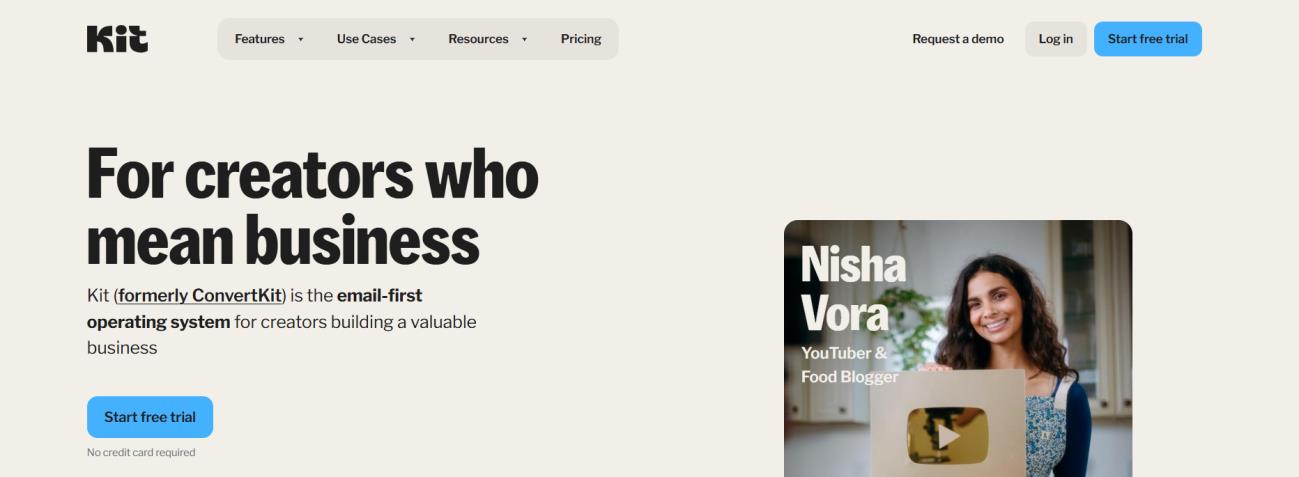
Pricing: Free for up to 10,000 subscribers. Paid plans start at $29/month.
Kit’s, a tool particularly favored by creators, reported a solid deliverability score of 91.3% as of January 2023. However, according to EmailToolTester, limitations with setting up subdomains and DMARC didn’t allow for a January 2024 deliverability score report.
Its focus on clean, text-based emails and high email marketing engagement means it naturally avoids many spam flags.
Kit also offers domain verification through SPF and DKIM setup to authenticate sender domains. It also provides basic deliverability reporting for open rates, bounce rates, and complaint tracking, giving users transparency and control.
The above, along with its simplicity and creator-friendly design, make it especially useful for newsletters and simple campaign flows for smaller creator businesses, for whom personalization and trust-building are key.
Pros
- Simple interface focused on content creators.
- Encourages deliverability best practices like plain-text emails.
Cons
- Lacks deeper automation logic.
- Basic design options may not be suitable for all marketers.
9. GetResponse

Pricing: Plans start at $16/month, includes a 30-day free trial.
GetResponse is known for its strong automation features, including workflows, segmentation, and personalization. It enforces anti-spam policies and monitors sending behavior to protect sender reputation and maintain a deliverability score of 89.7%.
GetResponse also offers list hygiene with automated bounce handling and unsubscribe management, to keep lists clean. Its engagement-based segmentation tools allow users to filter inactive contacts and improve deliverability.
At the same time, SPF and DKIM configuration is supported and well-documented, helping protect sender domains and improve inbox placement. However, DMARC configuration requires manual DNS setup outside of the platform, which is a drawback.
GetResponse can handle routine deliverability concerns automatically. However, active monitoring and manual checks are recommended occasionally, especially for high-volume senders. Its proactive tools make it a great option for teams that want a mostly automated approach to deliverability.
Pros
- Automated list cleaning and re-engagement workflows.
- Strict opt-in verification and content guidelines.
- SPF and DKIM setup is smooth.
Cons
- Entry plan limits some automation and testing features.
- Lacks built-in DMARC setup requiring manual DNS configuration that can be tricky for some users.
10. MailJet
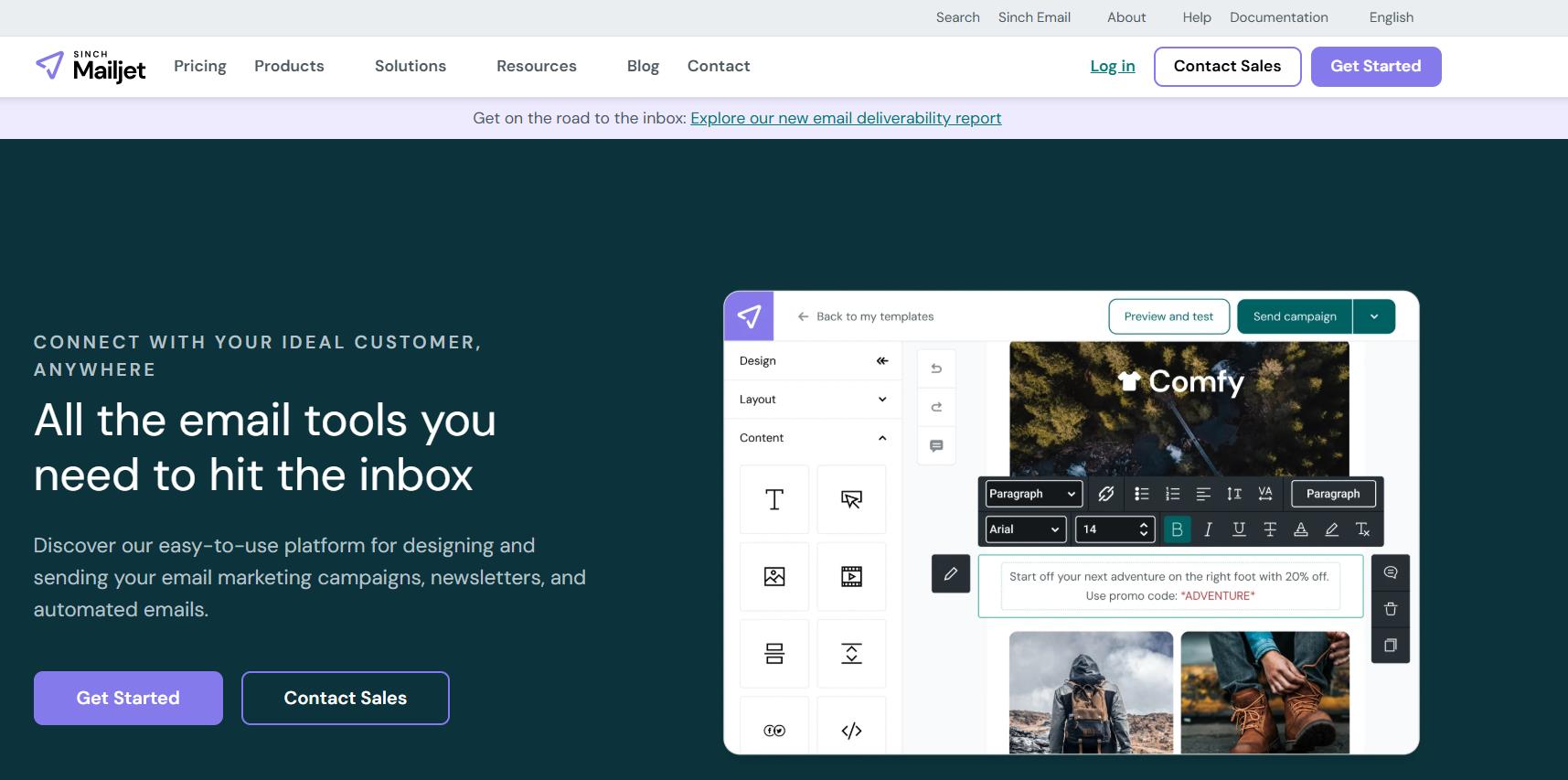
Pricing: Paid plans start at $17/month, free for up to 6,000 emails/month.
MailJet offers both marketing and transactional email sending capabilities within a single platform. With a deliverability score of 88.0%, this platform is another good email marketing option. Paired with Mailgun for transactional sending, it offers a complete solution for various email needs.
The platform supports SPR, DKIM, and DMARC authentication protocols, and sending domain verification is required and supported.
Its feature set is more utilitarian, with fewer marketing-oriented features. Instead, it focuses more on reliability and functionality. According to user reviews, it’s mainly preferred by developers and teams who need a solid transactional and marketing email management platform.
Pros
- Coupled with Mailgun, it offers a unified platform for marketing and transactional emails.
- Developer-friendly with strong API access.
Cons
- Less intuitive for non-technical users.
- Fewer marketing-oriented or creative email features.
Best Dedicated Deliverability Tools
Dedicated email deliverability tools give you the diagnostics and insights that platforms alone can’t. These solutions include email testing tools or specialize in spam score analysis, inbox placement tracking, and authentication checks, which are crucial for fine-tuning campaigns and protecting your sender reputation. These tools are your second line of defense after a strong ESP.
11. Moosend’s DMARC Checker
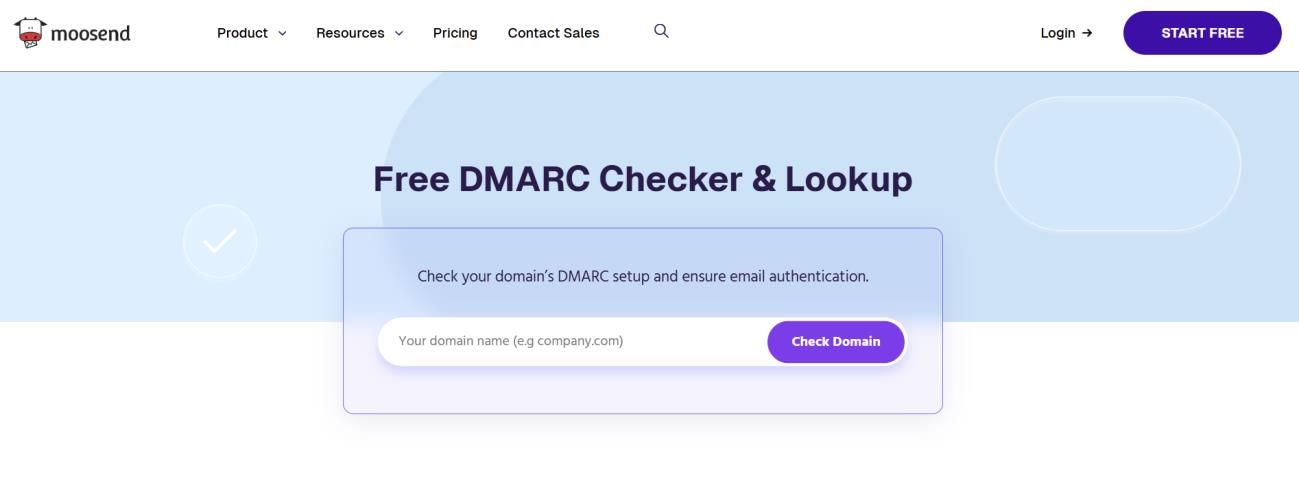
Pricing: Free
DMARC checking and validation are a key part of a broader email authentication strategy.
Moosend’s Free DMARC Checker is a no-frills, reliable tool designed to help senders validate their DMARC records. This is essential for authenticating domains and protecting sender reputation by preventing unauthorized use of the domain in phishing or spoofing.
By confirming the correctness of DMARC policies and verifying that SPF and DKIM align with them, this tool supports better inbox placement, as proper alignment helps ISPs trust your emails.
12. GlockApps
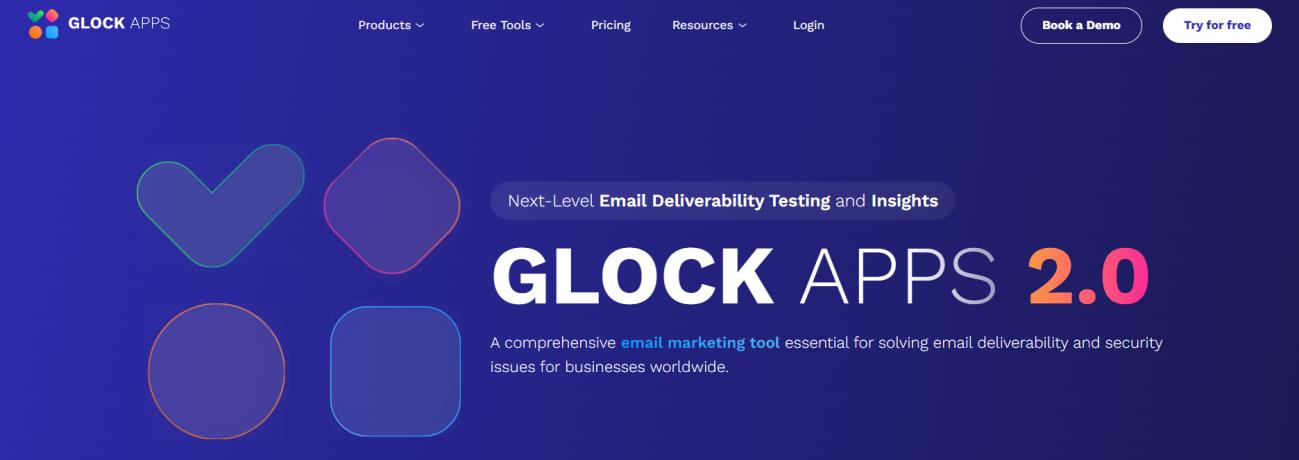
Pricing: Free plan available. Paid plans start at $59/month.
GlockApps is a powerful all-in-one deliverability testing suite that includes inbox placement testing, spam filter diagnostics, and tracking IP/domain reputation on major blacklists (blacklist monitoring).
It allows users to send test emails to a wide range of real email addresses across popular ISPs (Gmail, Outlook, etc), to track inbox and spam folder placement. This “inbox testing” gives senders a granular view of how emails perform, allowing them to diagnose deliverability issues before sending emails to their entire list.
13. Mailreach
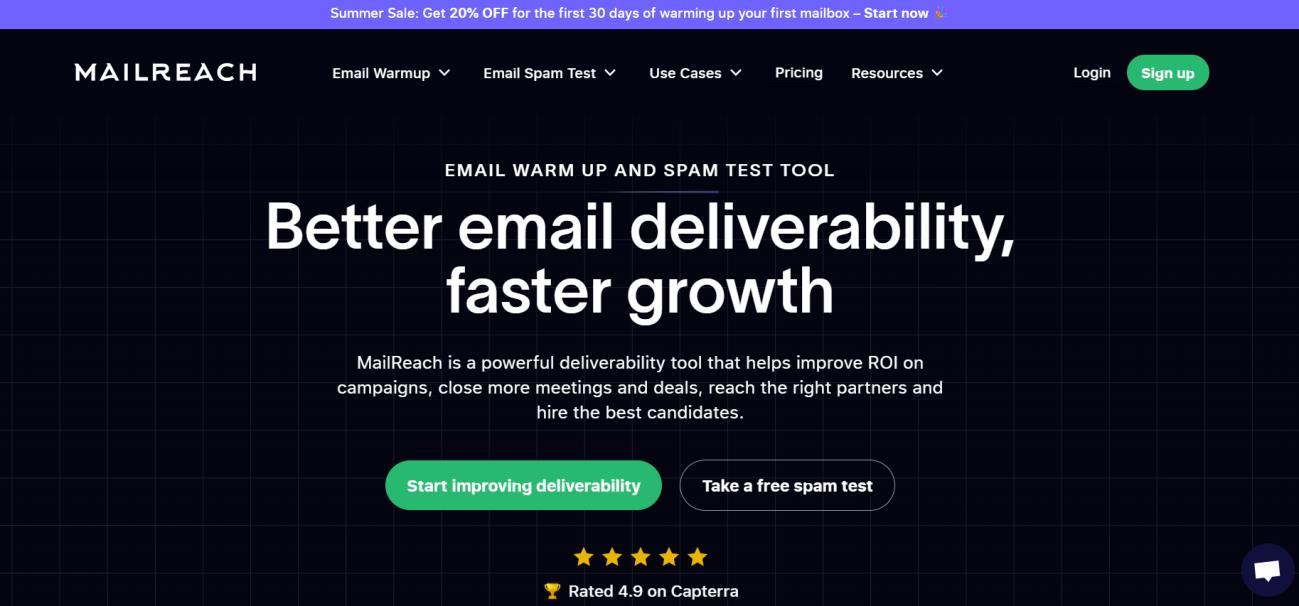
Pricing: Prices start at $25/month/inbox.
Mailreach is preferred by professionals who want to optimize their cold outreach campaigns.
It specializes in email warm-up, gradually increasing email volume and engagement to build a positive sender reputation. This is essential for new or dormant email domains looking to improve their deliverability.
The tool utilizes automated processes to generate realistic engagement signals, such as opens and replies, from its network. These behaviors help mailbox providers recognize sending activity as trustworthy, reducing the likelihood of a campaign being sent to the spam folder.
14. InboxAlly
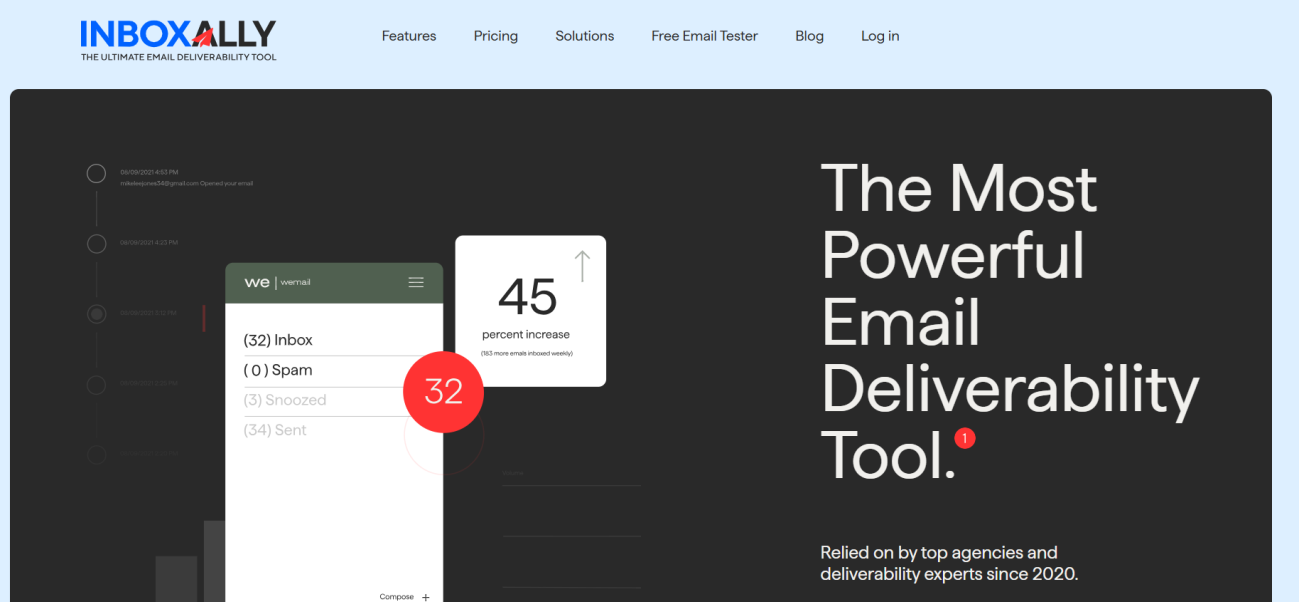
Pricing: Paid plans start at $149/month.
InboxAlly is an advanced inbox placement tool that helps boost deliverability by using real user interactions on your emails, like opens, bookmarks, replies, etc. This sends positive behavioral signals to mailbox providers, improving sender reputation and inbox placement.
The behavioral engagement InboxAlly generates is particularly valuable for cold outreach or new domains, where establishing trust with ISPs is challenging. It helps improve sender reputation and, thus, deliverability for high-volume marketers who need a tool to combine with their cold email software.
15. MailGenius
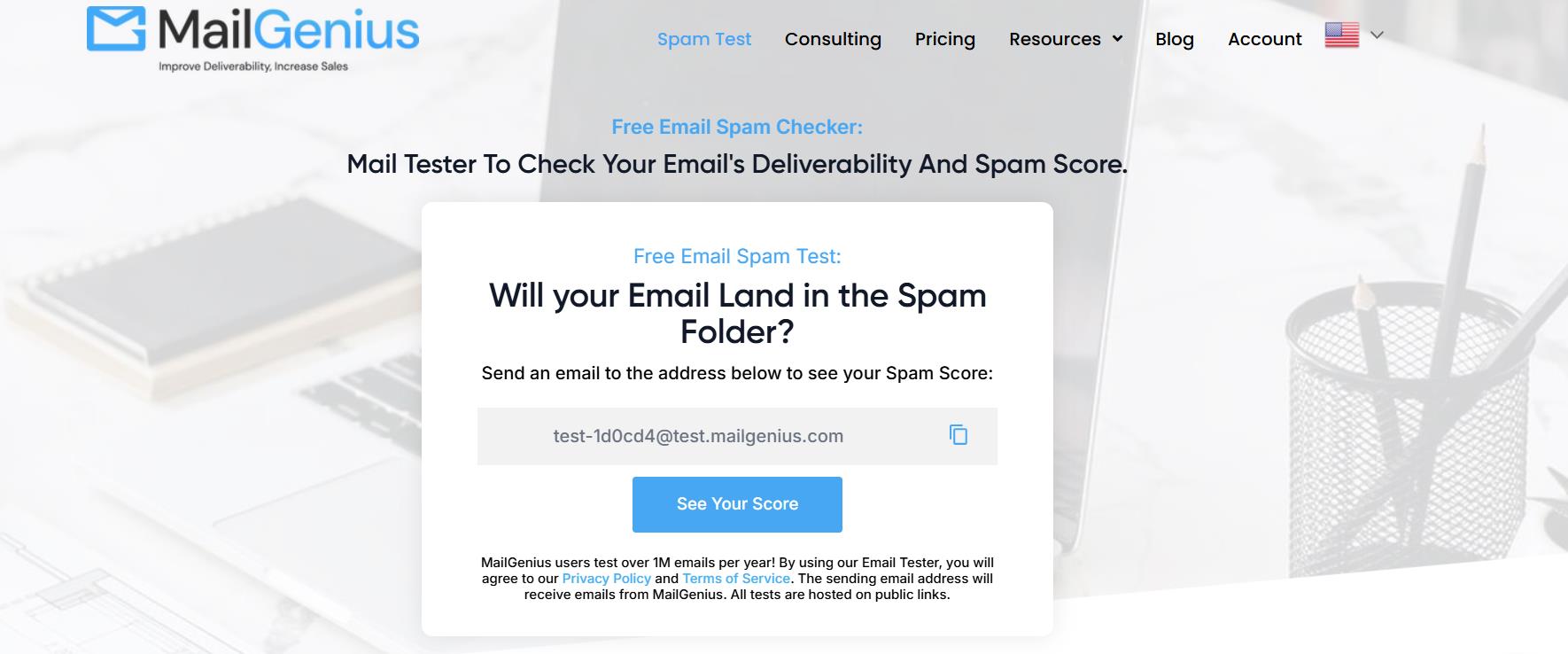
Pricing: Free version available. Paid plans start at $10/month.
MailGenius is a lightweight, easy-to-use email testing tool that audits your messages for spam triggers and authentication issues. It provides a simple interface to scan emails for common spam triggers, check SPF, DKIM, and DMARC authentication setup, and review header issues. The tool is designed for quick diagnostics rather than deep, ongoing monitoring.
While it doesn’t test actual inbox placement, MailGenius is great for fast pre-send checkups. It helps you catch potential issues with content or configuration before your emails go out.
16. MailTrap
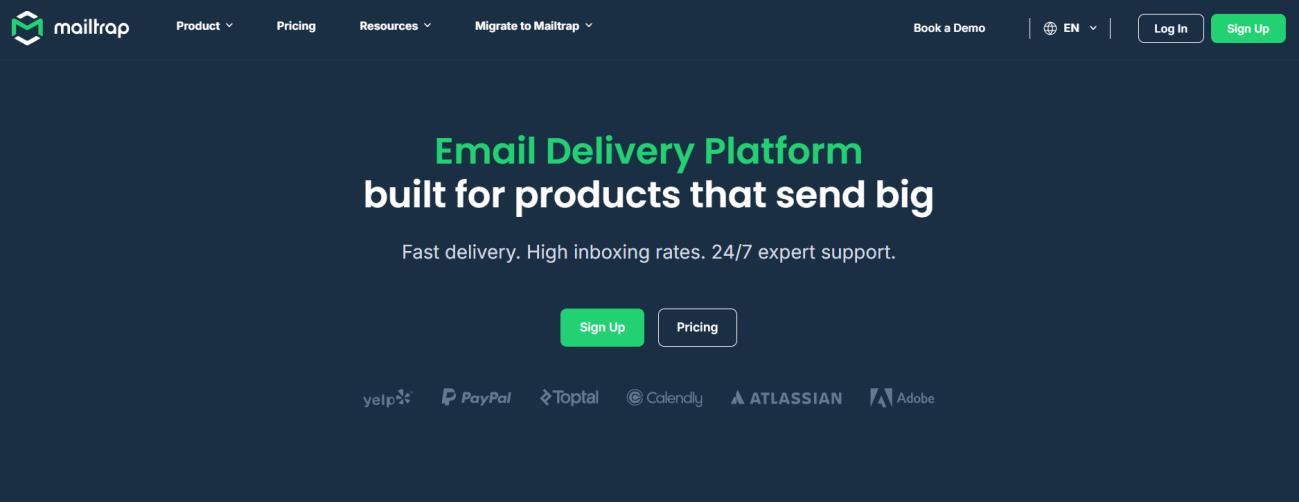
Pricing: Free plan available. Paid plans start at $15/month.
Mailtrap provides a virtual inbox where developers can send test emails without reaching real users. This is ideal for staging, formatting checks, and reviewing headers and content safely.
Mailtrap is widely used in QA and development environments to verify email templates and debug SMTP issues. It offers basic spam score analysis and email validation, which can help reduce issues when emails go live.
As a virtual inbox tool, Mailtrap doesn’t offer full deliverability or spam filter testing options, like the other tools mentioned on the list.
17. Postmark
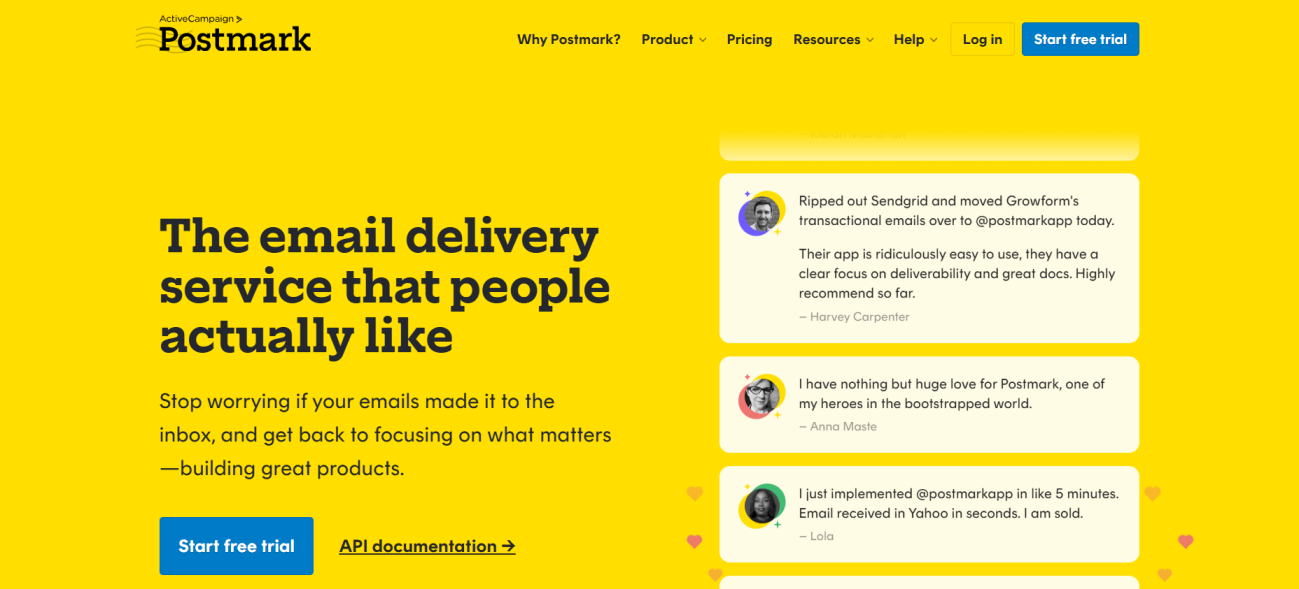
Pricing: Free trial available. Starts at $15/month.
Postmark is purpose-built for transactional email and achieves industry-leading deliverability by keeping its transactional infrastructure separate from bulk marketing campaigns. This helps preserve IP reputation and ensures faster, more reliable delivery.
Postmark emphasizes fast delivery times, which is a significant selling point for mission-critical messages, such as password resets and account verifications. This makes it one of the top choices for developers and product teams.
18. MXToolbox

Pricing: Limited free version. Paid plans start at $129/month.
According to users, MXToolbox is widely recognized for its extensive suite of domain and email diagnostic tools. It’s used by IT teams and email professionals to troubleshoot and monitor DNS, email authentication, and IP/domain reputation. While it doesn’t offer predictive inbox placement testing like other tools on this list, it’s among the most feature-rich infrastructure diagnostic tools.
From DNS lookups and blacklist checks to SPF, DKIM, and DMARC validation, it provides technical teams with deep insight into what might be hindering email deliverability behind the scenes.
19. ZeroBounce
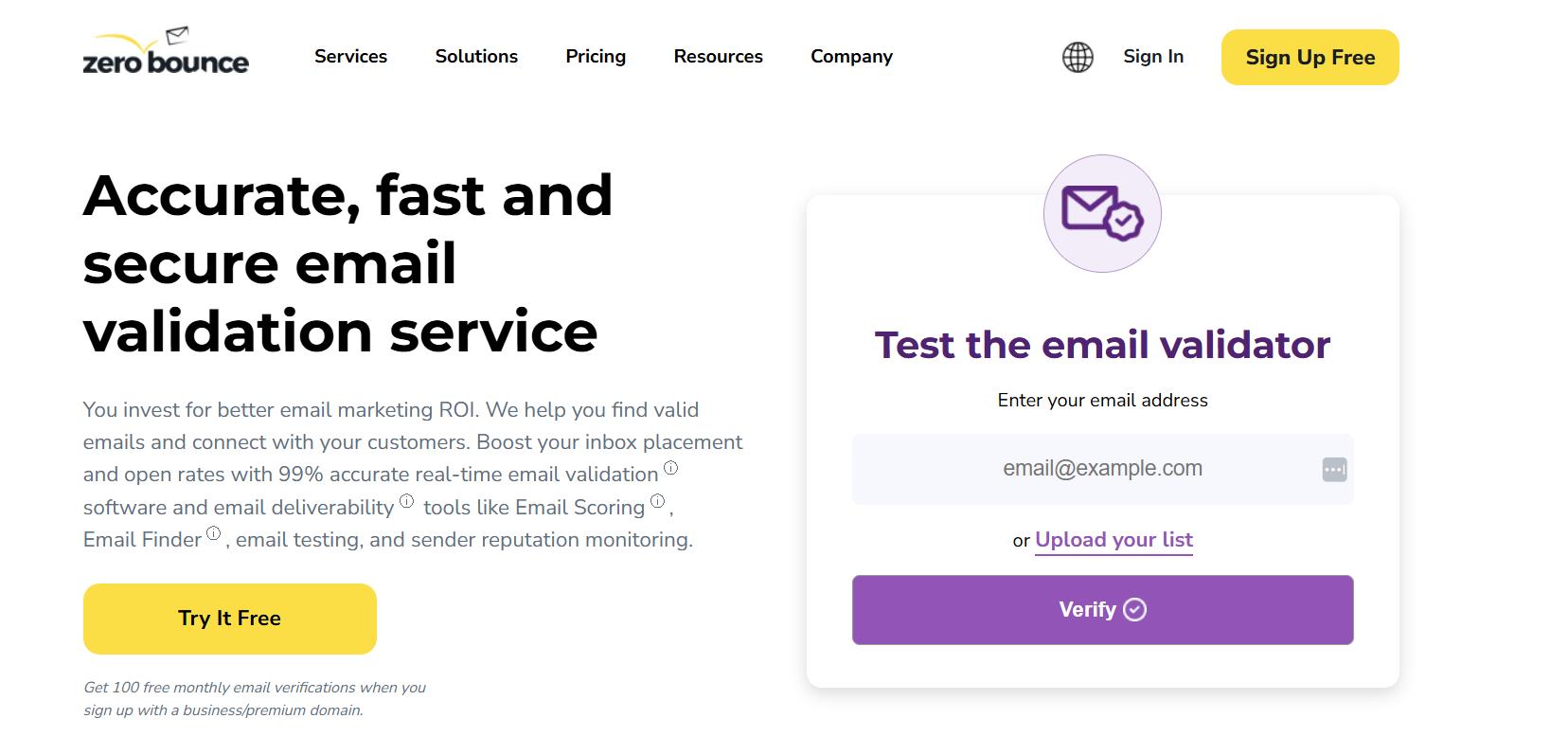
Pricing: A free toolkit is available. Paid plans start at $18/month.
ZeroBounce is a robust deliverability toolkit and email validation service designed to maintain clean lists and high inbox placement. It combines email list validation with deliverability tools, such as warm-up, DMARC monitoring, and inbox placement testing, to enhance email hygiene and improve sender reputation.
Beyond list cleaning, it provides inbox placement tracking, spam trap detection, and DMARC monitoring.
Ready to Boost Deliverability with the Right Tools?
Even the most beautiful campaigns are of no use if they end up in the spam folder. That’s why choosing the right email deliverability tool—whether standalone or part of an all-in-one platform—is essential for sending your message straight to the inbox.
Deliverability isn’t just a technical box to check. It’s your ticket to better engagement, higher open rates, and ultimately, more conversions.
Sign up for Moosend and start landing in the inbox every time.
Frequently Asked Questions
Below, you’ll find some common questions about email deliverability.
1. What is an email deliverability tool?
An email deliverability tool helps you monitor, test, and improve your chances of campaigns reaching the recipient’s inbox instead of being flagged as spam. These tools often include features like inbox placement testing, spam score analysis, domain authentication checks, and sender reputation monitoring. Some are standalone platforms, while others are built into all-in-one email marketing software.
2. How do I improve my email deliverability?
Improving email deliverability requires a multi-pronged approach. You need to authenticate your domain with SPF, DKIM, and DMARC records. Don’t forget to maintain clean lists by regularly removing bounces, inactive users, and role-based addresses. Use email testing tools to scan for spam trigger words, poor formatting, or blacklisted IPs. Segment your audience to send more relevant content and improve engagement rates. Lastly, warm up new domains/IPs slowly before sending large volumes.
3. What affects deliverability rates the most?
Several key factors influence whether your email lands in the inbox or spam folder:
- Sender reputation: ISPs use your IP and domain reputation to decide whether your email is trustworthy, while poor past behavior (spam complaints, blacklists, high bounce rates) lowers your score and increases the chance of being filtered.
- List quality: Sending to unengaged, outdated, or purchased lists often leads to spam complaints and high bounce rates, which damage the sender’s reputation. At the same time, ISPs monitor recipient engagement through opens, clicks, deletes, and spam reports, and adjust inbox placement accordingly.
- Email content: Email filters analyze content for things like spammy language (“Buy now!”, “100% free”), excessive images and their ratio to text, too many links, and bad HTML formatting. Content alone won’t get you blacklisted, but it’s a factor. Especially when combined with low engagement or weak reputation.
- Authentication: Proper email authentication helps prove your messages are legitimate, protecting against spoofing and phishing. ISPs look for SPF and DKIM alignment, and DMARC enforcement is increasingly required for bulk senders.
- Sending behavior: Deliverability suffers when you suddenly increase sending volume, send campaigns infrequently to large lists, or when your emails get low engagement. Warm-up schedules, consistent sending, and segmentation by activity level help avoid red flags.
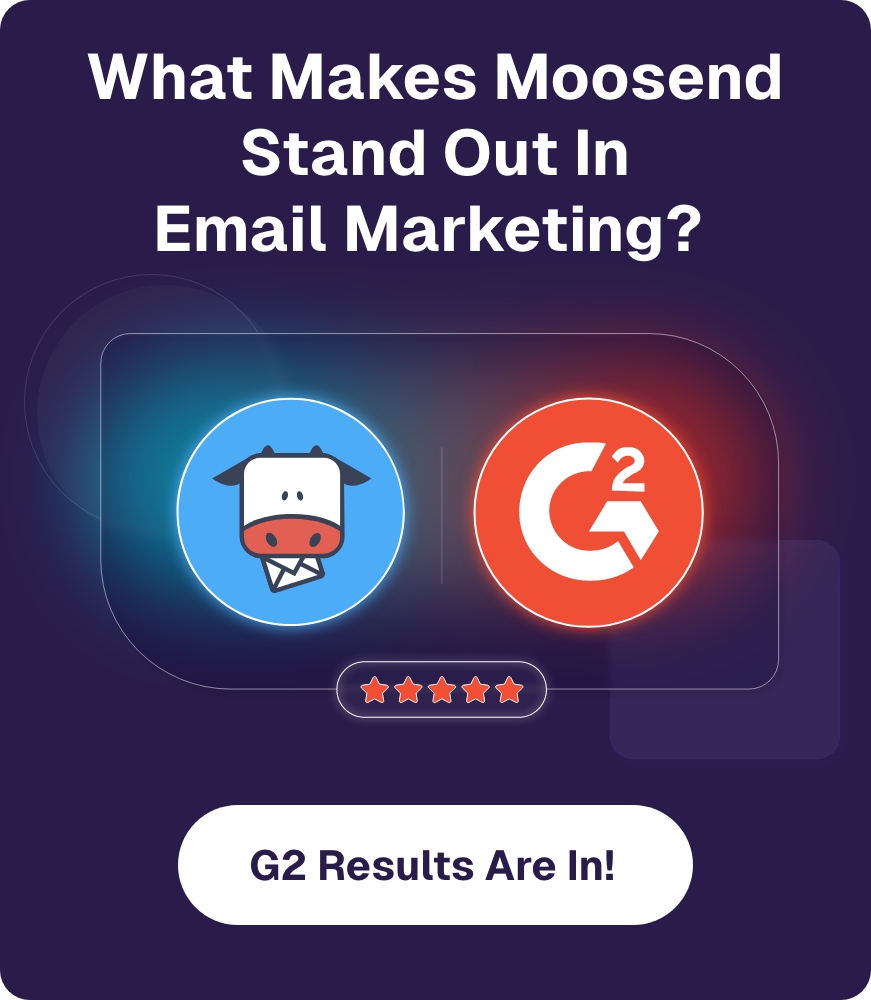



 Published by
Published by

 Published by
Published by
